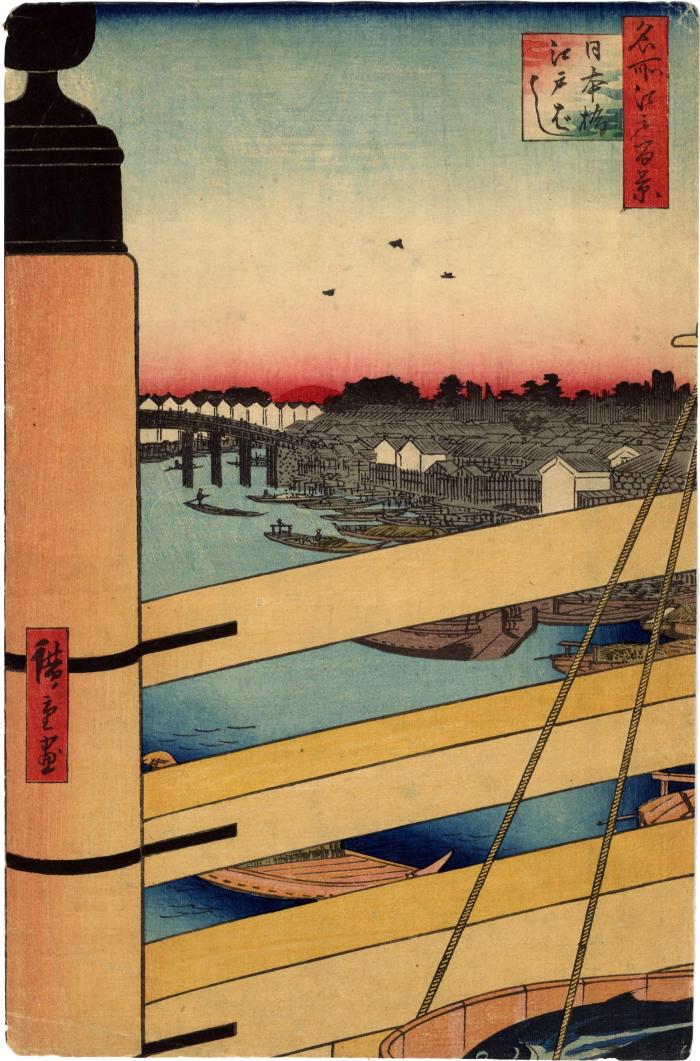Utagawa Hiroshige (歌川広重) (artist 1797 – 1858)
Nihonbashi Bridge and Edobashi Bridge (Nihonbashi Edobashi - 日本橋江戸ばし) from the series One Hundred Famous Views of Edo (Meisho Edo hyakkei - 名所江戸百景)
12/1857
8.5 in x 13 in (Overall dimensions) Japanese woodblock print
Signed: Hiroshige ga (広重画)
Museum of Fine Arts, Boston
Waseda University
Fine Arts Museums, San Francisco
Minneapolis Institute of Arts
Honolulu Museum of Art
Museum für angewandte Kunst, Vienna
Adachi Museum of Art
Muzeum Sztuki i Techniki Japońskiej Manggha, Krakow
Royal Ontario Museum
Royal Museums of Art and History, Belgium (via Cultural Japan)
Museum of Oriental Art, Venice (via Ritsumeikan University)
Chazen Museum of Art
Nationaal Museum van Wereldculturen (Rijksmuseum Volkenkunde, Leiden) via Ritsumeikan University
Brooklyn Museum
Edo-Tokyo Museum
The State Hermitage Museum
The National Gallery, Prague This copy from the Lyon Collection is trimmed all around. If it were a full sheet it would show the publisher - Uoya Eikichi (魚屋栄吉), according to many sources - in the margin, outside the image, along the lower left quadrant along with the date seal for 7/1858. However, Andreas Marks states that the name Uoya Eikichi is an erroneous reading and that the actual name should be read as Sakanaya Eikichi (魚屋栄吉). The censor's aratame and date seal for 4/1857 would appear in the upper right.
The color is very good and this appears to be from a very early edition.
****
Michael Uspensky wrote: "The Nihonbashi is easily recognized by the finials like tongues of flame on the posts of the railing. They were reserved for use on especially important bridges... Between the Nihonbashi and the Edobashi, there were markets on both sides of the river. The white-plastered warehouses in the upper part of the print were if not a sight, then a feature of the locality. Hiroshige chose to omit one of the main peculiarities of these buildings - the devices of the owners which were painted on them. There is a poem which reads:
If you cast a glanceWe are looking here at the south bank of the Nihonbashigawa, which was no less busy and commercial than Uogashi across the river. Wooden buildings extend along the bank, alternating with warehouses. Aomono-ichiba, the Green (Vegetable) Market that began near the Nihonbashi, was the destination for most of the boats loaded with freight seen in the print.
From Edobashi, the barns stretch out
All covered with every manner of badge.
The area immediately by the Edobashi was also known in the past for other businesses. There was a noted apothecary's, Mitsuhoshi ("Three Stars"), which specialized i plasters and ointments for various purposes. Alongside it was Kinokuniya, one of the best tobacco shops in the city.
The south bank between the two bridges was the venue for an annual event known as saizo-ichi. Saizo was the name given to the singers and actors who went from house to house giving small performances at the New Year. In the last ten days of the year, actors from elsewhere (mainly neighboring provinces) wishing to take part presented themselves at this 'talent show' where they were selected and rates of pay decided.
The composition is based on a sharp juxtaposition of planes: we look at the river through the superstructure of the bridge. Closer, almost level with us, places a basket that is hanging from a yoke (we only see the ropes hanging from the crosspiece) carried by a fish-hawker. The basket contains hatsugatsuo the 'first mackerel'."
Quoted from: One Hundred Views of Edo: Woodblock Prints by Ando Hiroshige, p. 106 with a full-color illustration on p. 107.
****
According to Hiroshige: l'art du voyage, Paris, 2012, p. 142 it says: "Mais cette estampe, dirigée vers le nord-est, représente l'autre rive, appelée Yokkaichi."
****
There are other copies of this print in the Manggha Centre of Japanese Art and Technology, Krakow, the Worcester Art Museum and in the Art Institute of Chicago.
****
Listed, but not illustrated, in Japanese Woodblock Prints: A Catalogue of the Mary A. Ainsworth Collection by Roger Keyes, 1989, #687, p. 202.
****
Illustrated:
1) in color in 浮世絵八華 (Ukiyo-e hakka), vol. 8 (Hiroshige), Heibonsha, 1984, #52.
2) in color in a full-page color reproduction in Hiroshige: 100 Views of Edo by Mikhail Uspensky, Parkstone Press, 1997, #41, page 107.
landscape prints (fūkeiga 風景画) (genre)
Sakanaya Eikichi (魚屋栄吉) (publisher)
